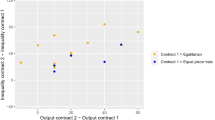Abstract
Two departures from antecedent rent-seeking models are invoked: a rent of unknown size is sought, and rent seekers obtain private imperfect estimates of this size. A symmetric equilibrium for a fixed number of rent seekers is characterized, and shown to underdissipate the rent. Then a model of the decision to obtain private information and participate in the rent-seeking contest is built. The symmetric equilibrium participation probability equates expected profit to participation costs. A simple formula for underdissipation results: dissipation is incomplete precisely by the expected aggregate participation costs. If an award mechanism can attain a lower level of dissipation for a fixed number of seekers, then it will raise the endogenous probability of participation, and as a result will dissipate less rent in the equilibrium with an endogenous number of seekers.
Similar content being viewed by others
References
Baye, M., Kovenock, D. and de Vries, C. (1990). The all-pay auction with complete information. Center for Economic Studies, University of Leuven. Unpublished manuscript.
Baye, M., Kovenock, D. and de Vries, C. (1993). Rigging the lobbying process: An application of the all-pay auction.American Economic Review 83: 289–294.
Becker, G. (1983). A theory of competition among pressure groups for political influence.Quarterly Journal of Economics 98: 371–400.
Becker, G. (1985). Public policies, pressure groups and deadweight costs.Journal of Public Economics 28: 329–347.
Capen, E., Clapp, R. and Campbell, W. (1971). Competitive bidding in high risk situations.Journal of Petroleum Technology 23: 641–653.
Harstad, R.M. (1990). Alternative common-value auction procedures: Revenue comparisons with free entry.Journal of Political Economy 98: 421–429.
Higgins, R.S., Shughart II, W.F. and Tollison, R.D. (1985). Free entry and efficient rent seeking.Public Choice 46: 247–258.
Hillman, A. and Riley, J.G. (1989). Politically contestable rents and transfers.Economics and Politics 1: 17–39.
Kagel, J.H. and Levin, D. (1986). The winner's curse and public information in common value auctions.American Economic Review 76: 894–920.
Kagel, J.H., Levin, D. and Harstad, R.M. (1994). Comparative static effects of number of bidders and public information on behavior in second-price, common value auctions.International Journal of Game Theory, forthcoming.
Leininger, W. (1992). The all-pay auction with incomplete information. University of Dortmund. Unpublished manuscript, Economics.
Maskin, E. and Riley, J.G. (1985). Auction theory with private values.American Economic Association Papers and Proceedings 75: 150–155.
Matthews, S.A. (1987). Comparing auctions for risk averse buyers: The buyer's point of view.Econometrica 55: 633–646.
Milgrom, P.R. and Weber, R.J. (1982). A theory of auctions and competitive bidding.Econometrica 50: 1089–1122.
Riley, J.G. (1988).Ex post information in auctions.Review of Economic Studies 55: 409–430.
Rothkopf, M.H. and Harstad, R.M. (1994). Modeling competitive bidding: A critical essay.Management Science, forthcoming.
U.S. Department of Commerce (1991).U.S. spectrum management policy: Agenda for the future. NTIA special publication 91-23, U.S. Government Printing Office.
Tullock, G. (1967). The welfare costs of tariffs, monopolies and theft.Western Economic Journal 5: 224–232.
Tullock, G. (1980). Efficient rent seeking. In J.M. Buchanan, R.D. Tollison and G. Tullock (Eds.),Toward a theory of the rent-seeking society, 97–112. College Station, TX, Texas A&M Press.
Wilson, R. (1977). A bidding model of perfect competition.Review of Economic Studies 44: 511–518.
Author information
Authors and Affiliations
Additional information
Bill Shughart and a referee offered encouragement and useful suggestions. They and Mike Baye directed me to relevant literature. The US National Science Foundation supported this research through grant SES 91-08551. I am grateful and solely responsible for errors.
Rights and permissions
About this article
Cite this article
Harstad, R.M. Privately informed seekers of an uncertain rent. Public Choice 83, 81–93 (1995). https://doi.org/10.1007/BF01047685
Accepted:
Issue Date:
DOI: https://doi.org/10.1007/BF01047685



